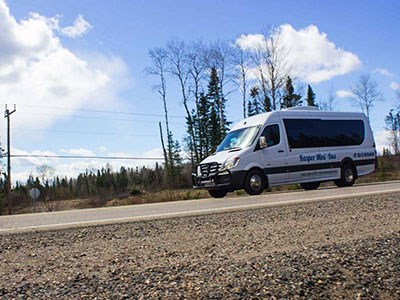An upstart transportation company is continuing to gain ground with its mini-bus service in northwestern Ontario.
Cuts to Greyhound bus service to communities in the region fueled the creation of Thunder Bay-based Kasper Transportation to step in and fill the void.
The company was planning to expand service with a dedicated three-times-a-day run between Dryden and Sioux Lookout by the end of June.
Kristian Kuznak, general manager of Kasper Mini-Bus service, said there’s plenty of commuter traffic between the two communities, heading to work, travelling to medical appointments, or spending a day shopping in Dryden.
To the east, after acquiring Porky’s Shuttle Service in March, the company extended its reach along Highway 11 into Longlac and now has reached further in making a thrice-weekly run into Hearst in May to hook up with the Ontario Northland’s bus service.
“(Porky’s owner) Peter (Hildebrandt) had a very good reputation in the region and we wanted to make sure that people felt that wasn’t going to change,” said Kuznak.
“Peter was still going to provide the great service he had been providing, just under a new name. Peter now works with us and drives with us to make sure the buses run just as well as he ever did and better now with the new vehicles.”
The company is owned by Thunder Bay businessman Kasper Wabinski, who also launched a new charter air service based out of the Dryden Airport last year, before seguing into regional bus service.
Many of their riders live by modest means, but they travel in style.
The company’s choice of going with four fully outfitted 16-seat and 11-seat Mercedes Sprinters vans, with leather seating and free Wi-Fi, has proved hugely popular with the riding public.
One van is equipped with a rear wheelchair access lift.
Since initially introducing service between Thunder Bay and Sioux Lookout — with stops at towns in between — last summer, Kusnak said the reception across the northwest has been “fantastic.”
Their promotions and prize giveaways, through their customer survey questionnaires, have been well received by all.
“Everybody’s loving the service.”
Ridership has been very good with consistently full buses, he added, especially on the Longlac run where on some days, “we’ve had to turn away people, which is never something you want to do, but it gets full.”
Kuznak said new runs to other unserviced communities like Red Lake and Armstrong are under consideration.
“We’re looking at all the options in the region to see if there are any communities that know that they need the service. They can always get in contact with us and we’ll look into the feasibility of it.”
A couple of communities within a two-hour drive of Thunder Bay have already approached them, he said.
“If people need the service, we’ll do it.”
With a staff of 28 employees, Kuznak said they’re looking to recruit more people.
“You’re going to see us everywhere in this region very soon. We’re always looking for new people if they’ve got the drive to be part of a rapidly expanding new business and be part of something (that’s) changing the North.”
Inter-city bus service has been prominent on the agenda of Common Voice Northwest, a grassroots public policy think tank. A report they commissioned last year pointed out gaps between communities where no service exists. The group is now lobbying the provincial government to consider subsidies to support bus service.
While providing subsidies to carriers to reach some isolated communities might be warranted, it’s not just profitable for a bus company to do so, Kuznak said.
“Is it necessary? I think a good business will try to work it out as best as possible first and see if it’s viable before saying, we could use some help here. So far we haven’t had any issues in making everything work. It’s just a matter of being creative and getting out there.
“You just have to be willing to take the risk and try and help these communities. If you can’t figure out a way to get it going then you’re not trying hard enough.”
It’s why the company is running with small vehicles rather than full-size, 50-seat highway coaches, he said.
“You look at the market itself and see what it can bear. That’s why we chose to run a smaller and leaner service so we can get those niches that the larger vehicles are too expensive to run. That’s the direction we decided to go because that’s what the region requires now.”




